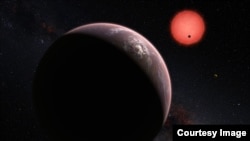So far we are still alone in the universe, but little by little, astronomers around the world are expanding our celestial neighborhood. They just announced three new candidates that could potentially support life.
And they're only 40 light years away, in the constellation Aquarius.
The three planets are orbiting what is called an ultracool dwarf star and have temperatures well below the 400 Kelvin range (about 120 Celsius) that is considered cool enough to support life.
The reason it has taken so long to find these close-by planets is because dwarf stars are invisible to optical telescopes.
Well Hello There!
Scientists from the Massachusetts Institute of Technology (MIT) and the University of Liege in Belgium used a special telescope called TRAPPIST to focus on the dwarf star, which is about the same size as Jupiter.
By comparison, about 1000 Jupiters would fit inside our Sun.
What they found circling in rapid orbits around this tiny giant were three planets, about the same size and temperature as Venus and Earth. All three planets, the researchers say, are likely to be tidally locked, meaning they have a sun side and a dark side. That's a bit of bad news for life because the bright sides are likely too hot, and the dark sides too cold to sustain biological activity.
But the scientists say there could be a "sweet spot" in permanent twilight where life could flourish.
What now?
"Now we have to investigate if they're habitable," said Julien de Wit, co-author of the article describing the finding in the journal Nature.
And these planets are close enough, de Wit says, "we can study their atmosphere and composition and further down the road, which is in our generation, assess if they're actually inhabited."
de Wit also says that several giant telescopes currently under construction, such as the E-ELT being built by the European Southern Observatory, and the James Webb Telescope that is due to be launched in 2018, will be able to search for "water, and ultimately signs of biological activity" on the planets.
In the meantime, the team says as many as 15 percent of the stars close to earth are these kinds of ultracool brown dwarfs, so there are plenty of other places to look for more planets.
Think of it as getting us one step closer to discovering if we have neighbors.












